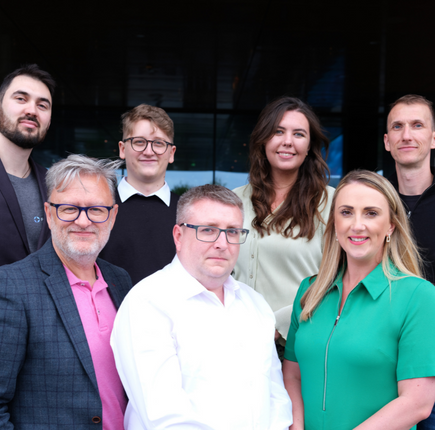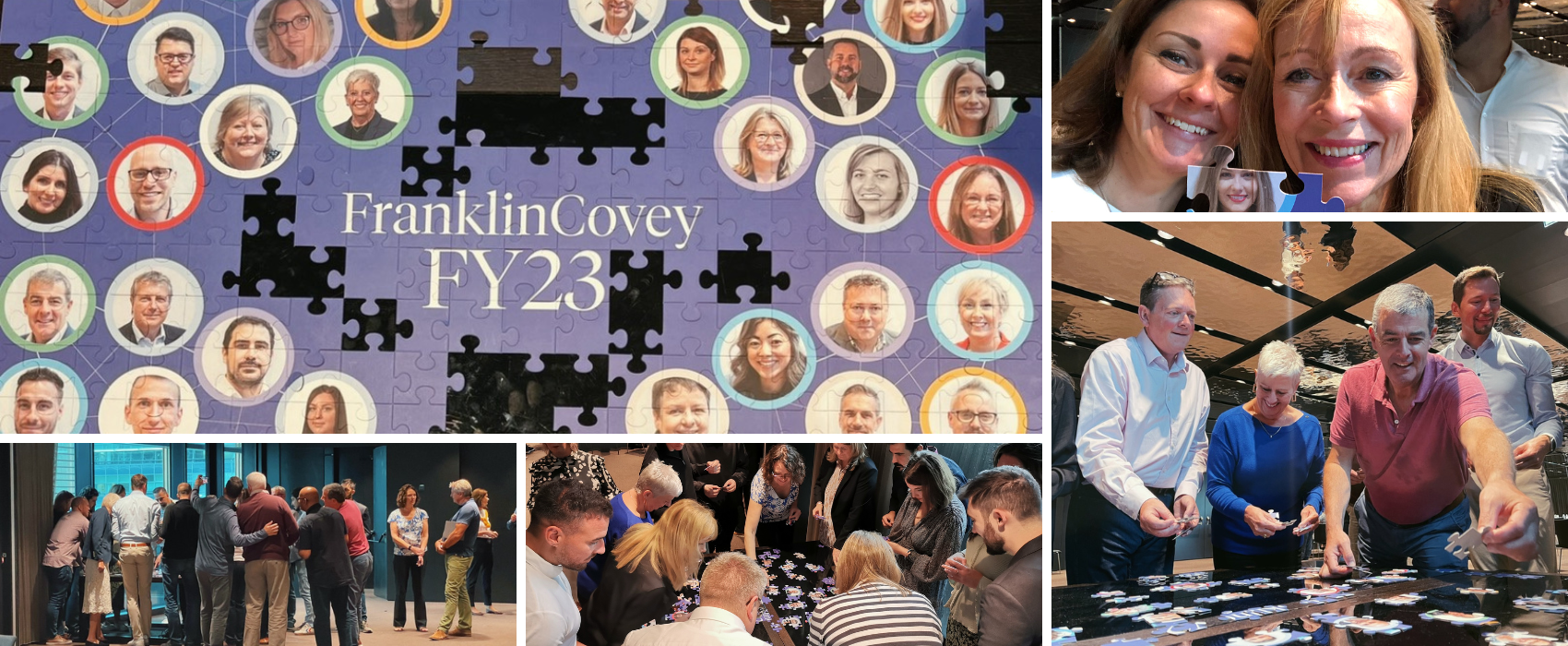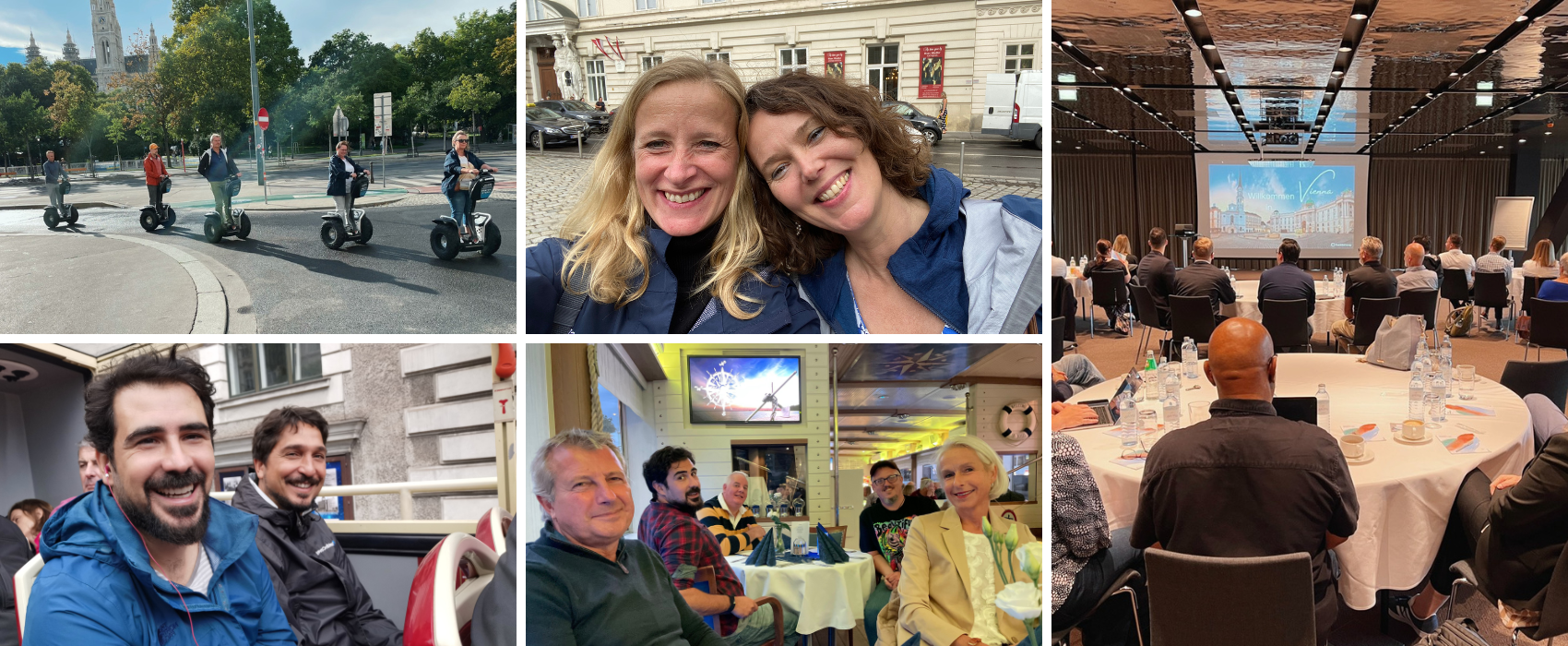Connection is Central to Everything
Jessica Doyle
21st November 2022
- 9 min read

Last week the world population hit 8 billion. There is more opportunity to meet new people and talk to more people than there has ever been before. To reach people on the other side of the world and in different time zones. Yet, in many ways the know-it-when-you-feel-it state of being connected is more elusive and takes more intentional cultivating today than ever before. Are we missing a trick?
This knowledge inspired the theme of our annual kick off in Vienna back in September. The event itself was a microcosm of the larger goal: to bring together dispersed, international teams to learn about and focus on what it means to be connected. We took the time- days- to look at what meaningful interactions look like, celebrate both collective wins and exceptional individual achievements, crowdsource ideas and reflect on FranklinCovey’s mission.
We learned a lot. This blog delves into the many corners of connection: what it is, why it’s so important, and steps to prioritise it.
The state of relationships at work today
A 2019 report by The Institute of Leadership and Management found that building close relationships with colleagues was the most important factor in determining job satisfaction by 77% of respondents. The upheaval, isolation and reimagining over the last few years has challenged our ability to forge and nurture these relationships.

Reflecting on FranklinCovey’s focus on connection this year, Curtis Bateman, VP of Interntional Direct Offices, observed “After the pandemic, people were focused on one video call after another even when in the office – not taking time to visit at the coffee machine or at lunch. The benefits of being physically in person had become logistically and emotionally more difficult to foster. Simply being in the same room didn’t always have the naturally revitalising, nourishing effect so many of us had imagined during our long periods apart”.
Increased stress and workload have blurred boundaries, shortened fuses and increased blinkered thinking. The ‘always on’ nature of work can lead to a superficial sense of being close to co-workers, whereas in reality we’re overloading ourselves with transactional, impersonal interactions. Without curiosity, vulnerability and intentionality, we’re more at risk than ever to miss out on the unique human context essential to mutual respect and understanding.
The benefits of being physically in person had become logistically and emotionally more difficult to foster. Simply being in the same room didn’t always have the naturally revitalising, nourishing effect so many of us had imagined during our long periods apart.- Curtis Bateman, FranklinCovey VP, Direct International Offices
The Harvard Study of Adult Development, the longest running study on adult life, health and happiness, found that relationship satisfaction at age 50 was predictive of health at age 80. If fulfilling relationships actually impact how we physically age, imagine their potential to influence the growth and health of a company.
Now is a good time to do a vitals check on the connections which underpin every aspect of your business: peer to peer, leader to team member and employer to employee.

What does ‘connection’ at work mean?
We all have some sense that connection at work is important. According to OC Tanner’s 2022 Global Culture Report the likelihood of great work falls by 90% when employees don’t feel connected to their workplace and culture. But the idea of “connection” is can be an intangible, easily misnamed concept.
It is not simply talking frequently or forging friendships- though they both play a part. Holistically speaking, connection is a sense of belonging. Of feeling seen, heard and valued. It’s that feeling that we matter to other people, as a member of the team and as a vital role in achieving the organisational goal.
Another way of summarising connection is the manifestation of what Stephen R. Covey described as the four basic needs of the Whole Person:
Body (how we live, physical wellbeing, energy, self-care)
Mind (our ability to learn, personal vision and aspiration)
Heart (our unique passion, strength of relationships, compassion)
Spirit (the overall guiding force which seeks meaning, contribution and purpose)
Connection then is simultaneously a grounding and unleashing force central to the success of everything we do. Sound powerful? It is.
How does building ‘connection’ connect to the success of your business?
Connection helps overcome unconscious bias
Unconscious bias is able to influence our opinions about people, situations and decisions without us realising or understanding why, impacting business outcomes in unnervingly stealthy ways. Authentic connection helps combat this by inviting in different world views, and maybe even giving ourselves permission to feel a level of discomfort in the process.
Have you ever had a feeling about someone, or believed you had a particular colleague sussed, only to later realise your perception had been way off the mark after truly getting to know them? That was a connection proving your unconscious bias wrong.
Connection fosters inclusivity
Little thought is given to how ableist and exclusive it is to talk about the value of colleagues or employees based on their “cultural fit” and how they “click” with the team. We are becoming ever more educated on the subject of neurodivergence and different communication styles. Learning that connection is not only about personal friendship helps us to build relationships outside of our “bubble” and fosters a greater understanding of the world and people around us.
Connection creates tighter, higher performing teams
Synergy, the sixth habit of The 7 Habits of Highly Effective People, is the highest form of collaboration and unlocked potential, and it requires accepting that the whole is greater than the sum of its parts. Synergistic teams reach new and exciting ideas that couldn’t be created alone, solve more problems and think more creatively by having an openness to others and new ways of seeing things.
Synergy is better than my way or your way. It’s our way.
Connection aligns goals and values between employees and business
It is people who make the productivity wheel go round, and people need purpose and fulfilment to do their very best work. Connecting employees to the wider mission, vision and goal creates a galvanising sense of ownership and accountability for employees. They feel like they are part of something bigger than themselves, which increases their motivation and commitment.
The more connected an employee, the more likely they are to remain an employee
A connected company is a ‘sticky’ company. The better you can get people to connect with you as a leader and your business, the more engaged they’ll be – and the more likely they are to stay in their job (and actually give it their all while doing so). According to a report by Blueboard, 80% of employees want to work at an organisation where they feel connected to the purpose and the people – and 3 in 5 would consider walking if they didn’t feel connected at work.

How do you create a culture of connection?
Whether your organisation is office first, remote or hybrid, connection is powerful to feel, but difficult to foster. What behaviours can you model and opportunities can you create which empower your employees to connect more to each other, their work and you as their leader/employer?
Make giving recognition routine
Research shows companies that use recognition as a tool for workplace connection are nearly twice as likely to report that they’ve adequately addressed employee connection challenges than the average. Giving recognition as a leader makes good business sense because the greater someone perceives their value to be, the more excited they are to live up to those expectations- and exceed them.
The power peer-to-peer recognition has is even more profound. One of the initiatives which came out of our company kick off this year is a weekly invitation every Friday to Give Kudos, which encourages self-reflection, facilitates interdepartmental understanding and makes giving credit a habit. Simple moments of gratitude have the power to create a workplace people feel they belong to- both personally and professionally. Read our blog on recognition to learn four ways you can prioritise it.
Train leaders in the signs of overwork
When the sole reason co-workers interact is to do with a task or under pressure, empathy suffers at the hand of efficiency. Work begins to feel like a chore, terse words become the norm and wellbeing plummets. Leaders and managers need to be attuned to signs of overwork and then equipped to provide tailored support. This requires the ability to be discerning in the capacity of employees, which can only happen when they’re seen and led as ‘whole people’.
Keep investing in people as people
Invest in employees as whole people, with lives outside of work, and motivating factors that go beyond toeing the company line. Listening is investing – take note of what your employees actually want and need, rather than presuming. Once leaders understand what makes team members tick, they’re positioned to offer individualised opportunities for growth.

Make time for coming together
Whether it’s a book club (something we have a soft spot for), team building days, informal meals or formal company events, it’s important to ensure your organisation is seen as a place for living, not just working. Rapport, laughter, camaraderie all serve to build trust and improve wellbeing.
Involve employees in creating solutions
One of surest ways increase employee connection to your organisation’s mission, increase collective understanding and confidence in the future is to ask for their feedback. Ask them how to fix things, how to improve, what they need from you to better do their job and feel happier whilst doing it. As part of our annual kick-off event this year we organised multiple round tables on a range of topics from how information is shared, the efficiency of processes, our knowledge of how each role connects to success.
Define your working model
‘We’ve gone hybrid’ is not definitive. It’s important to clearly define what aspects of work are better done in the office, and what’s best reserved for home. To avoid the issue of team members who are like proverbial passing ships, try establishing core days in the office, having routine in person meetings or becoming more intentional about external team building events, so that all employees have the chance to build relationships face to face.
Don’t risk disconnection
The cost of a low connection workplace is simply too great. Competitive, forward-thinking companies can’t afford to not take the time to understand, identify gaps and empower grounding connection in an overwhelming world. It doesn’t require grand gestures, just daily intentionality, psychological safety and consistent focus on employees and colleagues as whole people.





